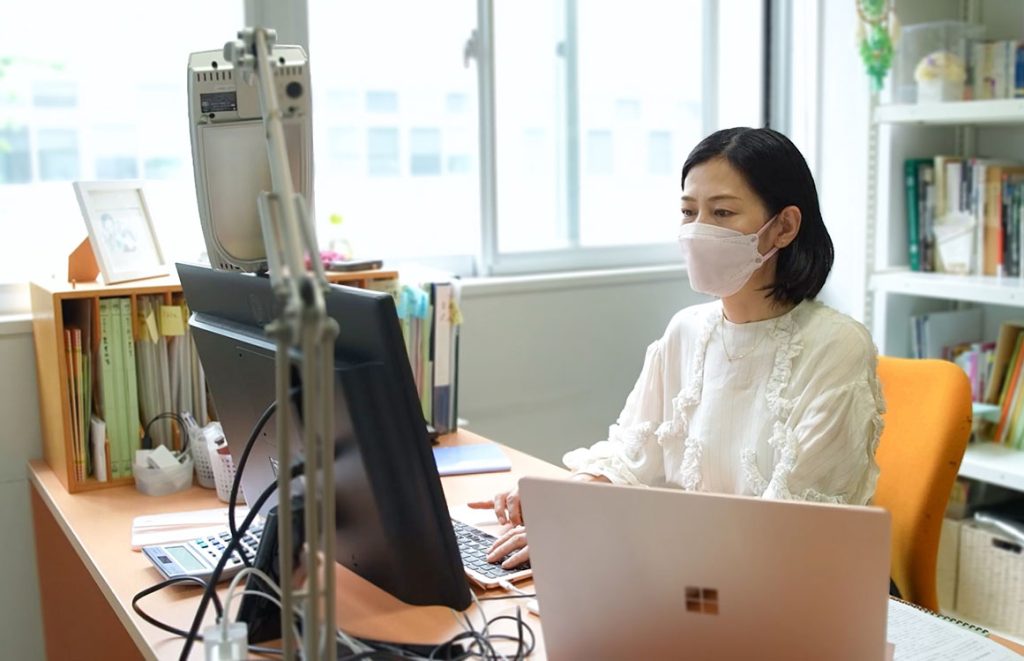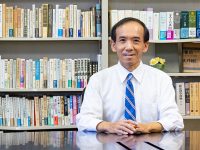The role of community gardens in connecting disaster victims

After an initial glut of photographs of disaster sites, reports of disasters quickly fade from the media as a topic of interest. However, the reality of the road to recovery is much longer, taking a decade or even two.
For over a decade, Professor Noriko Akita, a professor at the Division of Disaster Life Support Sciences under the Research Institute of Disaster Medicine, Chiba University, has been supporting reconstruction efforts after the Great East Japan Earthquake based on resident-led community garden creation activities. We asked her about the significance and research prospects of the Division of Disaster Life Support Sciences, which is engaged in recovery efforts from the perspective of disaster victims trying to return to the normalcy of their daily lives, while being scarred from calamities.
How to engage with disaster victims who have lost their loved ones, places to live, and physical and mental health.
I understand that the Division of Disaster Life Support Sciences is engaged in reconstruction support efforts through gardening as a practical activity. But why gardening?
The direct catalyst was the students who came to me and expressed their desire to go to the affected areas and help with reconstruction efforts through green and flowers right after the Great East Japan Earthquake. We were unsure what to do in the chaos immediately following the disaster. However, I thought that responding sincerely to the hopes of students was something I could do for the affected areas, so I contacted local governments and took students to the disaster-stricken areas.
Since the affected areas are subjected to construction restrictions* under the Building Standards Act, not many activities can be done immediately. Additionally, it was unclear for a long time what form of revitalization could take place in the areas designated as Disaster Risk Areas.** Under such uncertainties, flower planting was a feasible and flexible activity that could make temporary use of a given piece of land and easily return to being a vacant lot when full-scale reconstruction plans were set in motion.
*Building Restrictions in Afflicted Urban Areas: Based on Article 84 of the Building Standards Act—to prevent constructions that may hinder or prevent the sound reconstruction of affected urban areas—constructions of buildings in such affected areas are restricted or prohibited for one month from the date of the disaster. This restriction can be extended for up to two months. However, with the Great East Japan Earthquake, a special measure was established to promote the sound reconstruction of the severely damaged urban areas, restricting such constructions for up to six months (or up to eight months in the case of extension) from the date of the disaster.
**Disaster Risk Area: Based on Article 39 of the Building Standards Act, the local government may designate areas with a frequent danger of tidal waves, high tides, floods, etc., as Disaster Risk Areas by ordinance. Existing buildings are not prohibited from existing, but there are restrictions to new constructions and rebuilding activities.

In what way have the affected areas recovered through the community garden?
The disaster victims not only suffered physically and mentally, but their place of residence was also deprived by the disaster. Furthermore, many must continue their lives in a place whose landscape has changed completely. With so many lives lost on that day, I have even heard of people who were so overwhelmed with a sensation that made them question whether they, themselves, were still alive.
Even in a world where all color and sound have been lost in the immediate aftermath of a disaster, when the soil is tilled and flowers planted, bright colors return to that spot. Plants are living just like us, allowing one to feel the power of life tangibly. At the beginning of our activities, we found many things in the rubble that reminded us of the lives that were once lived, so we carefully preserved them. There were also flowers that did not match the soil inundated by the tsunami or its climate, so we went through many trials and errors. However, gradually, it became a community garden that connected local residents with one another and with those who were supporting the recovery efforts. Some community gardens were demolished once the reconstruction projects had gotten underway. Still, some gardens were carried on and are carefully cultivated by the local groups to this present day.
Disaster victims regain their initiative at a pace that suits them
The everyday process of seeds and seedlings growing and flowers blossoming overlaps with the hope for reconstruction.


Plants change little by little, day by day; these daily changes give us hope for tomorrow. One can also get a real sense of change and growth on a much greater time scale, measured in years. When people go through the process of planting and caring for plants with their own hands and changing the landscape and surrounding environments, I believe that they get the confidence that they can reconstruct their town by themselves.
Such initiatives taken by local residents are very important for the revitalization of the town. Each shall hold a keen desire to say, “I’m going to take care of our town” and “we’ll also contribute in whatever way we can, so we can continue living here.” However, if large-scale reconstruction projects proceed without the proactive participation of the impacted community members, it is difficult to foster their willingness and initiative. The community garden, at its scale, gives people a tangible sense that they are creating a place with their own hands to improve their town. From the viewpoint of Disaster Medicine, their own proactive actions and initiatives are crucial in the recovery from being “patients.”
So, it seems important for people to be directly and actively involved with regeneration.

In the immediate aftermath of the earthquake, I joined a workshop on reconstruction planning. I was deeply impressed by the local high school students who shared their ideal future for their town, saying, “It would be best to return the town to its pre-disaster state.” They did not want to adopt a drastic reconstruction project that would turn them into a town they did not know. Instead, they wished to approach reconstruction at their own pace and in a way that suited them, as they were to regain their mundane, everyday happiness. We need to consider that “creative recovery” is a different kettle of fish from recovery efforts during rapid economic growth. It is also important to “de-grow.” It makes our activities sustainable within the limits of what we can do without straining ourselves, particularly in a culturally and economically mature society.
The significance of sustainable landscape restoration through gardening

I first thought that gardening and disaster recovery seemed like an unusual combination, but I now see they are deeply related.
In fact, landscape architecture was a field developed exactly 100 years ago in the wake of the Great Kanto Earthquake. This field is involved in designing green spaces that also serve urban functions, such as firebreak zones and parks that serve as evacuation centers. Of course, these spaces also have everyday functions in our ordinary life, such as environmental conservation and the maintenance of the health of its citizens.
What is more important, is the nature of parks and green spaces as places to enjoy daily life. How do we shape a town in such a way that we can enjoy its beautiful greenery and flowers in comfort and joy as part of our mundane happiness? This is also an essential theme in the field of landscape.
It is necessary to have the eyes of an expert who has a long-term vision for the state of the town while also being respectful of the self-motivation of the local residents during the provision of support on-site.
Many students have participated in the project and are working together with the residents of the affected areas

When young students are around, they enliven the atmosphere, and many people say they are cheered by their presence. While many tend to become wary when they think a specialist is coming, they tend to open up and speak their true feelings when students arrive. I basically tell the students to listen to the voices quietly of the local residents. I believe that by listening to the voices of the people in disaster-stricken areas—through our activities and learning, while being involved in their local activities—they will be able to grow greatly as leaders of the future.
From the Faculty of Horticulture alone, a total of more than 1,500 students have participated in gardening activities in the affected areas. Going forward, I expect that we will be able to create more comprehensive and interdisciplinary disaster medicine by expanding our efforts for inter-institutional collaboration beyond the Departments.
Expectations for a future of interdisciplinary connections through networking
Tell us about your expectations for collaborations with the other divisions of the Research Institute of Disaster Medicine
From a medical perspective, landscape management and gardening are unique fields related to long-term recovery, which is why I think many new things could emerge.
While some of the victims may become patients, before all else, we need to keep in mind that they are all residents.” Through interdisciplinary exchanges, we can share each other’s situations and understanding, such as the relationship between physical and mental recovery and the restoration of living spaces or participation in local resident-led activities to regain daily happiness. This could provide many hints about the actions and stress responses of specialists who have been on-site in disaster areas.
The Research Institute of Disaster Medicine is comprised of a diverse group of divisions. Their research fuses and accumulates insights that can provide multifaceted support to disaster-stricken areas. This attempt would not have been possible without the collective strength of Chiba University, which has many unique faculties, including the Faculty of Horticulture and the Faculty of Nursing. I have high expectations and hopes for more such fruitful collaborations.
What kind of research are you considering for the future?
Landscape management often involves policymaking and requires an objective, long-term perspective. I would like to conduct various research, review case studies, and explore how reconstruction should be carried out so that the residents can return to their happier, more mundane lives.
It is also important for citizens to take the initiative in risk communication to face disasters in times of normalcy. We also plan to create a community garden network with local residents for sustainable communities.
One last thing: gardening can provide many opportunities for women to play an active role, and thus we can also put our hopes in it from the perspective of diversity. Although it is still difficult for women’s voices to be heard in disaster-related efforts and engagements, I hope to open a path through our activities and continue to seek for better disaster recovery.

Series
“Disaster Medicine” to Protect our Mind and Body from Disasters
The Research Institute of Disaster Medicine aims to build a disaster medicine and nursing system in the post-corona era. In addition to researchers of medicine, pharmacy, and nursing, those of horticulture, engineering, humanities, and sociology work together to create a new society.
-

#1
2022.10.25
Creating a Pandemic-Resilient Society to Tackle Future Invisible Enemies
-

#2
2022.12.07
Shedding Light on the Public Health Nurses Working at the Front Lines of Disaster-Stricken Areas
-

#3
2022.12.12
What causes nations and regions to perceive the COVID-19 crisis differently?〜Insights from the Humanities and Social Sciences Needed for Disaster Management Research
-

#4
2022.12.20
Let Community-Based Disaster Reconstruction take roots
-

#5
2023.02.23
The role of the Research Institute of Disaster Medicine (RIDM): The indispensable research hub for urban digital transformation
-

#6
2023.02.27
Affecting behavioral changes through a combination of mind and body: How can we calmly cope with stress in the event of a disaster?
Recommend
-

Reassessing the role of “Forest Resources” in achieving carbon neutrality: Measuring forests with the combination of drones, mathematics, and computer graphics
2023.09.12
-

Shedding Light on the Public Health Nurses Working at the Front Lines of Disaster-Stricken Areas
2022.12.07
-

From ELSI to RRI: Exploring the Ethical Landscape of Science and Technology
2024.11.21








